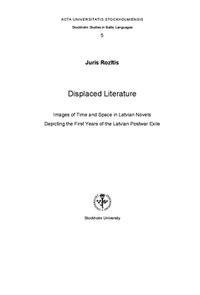
endast ny
Displaced literature : images of time and space in Latvian novels depicting the first years of the Latvian postwar exile
In the years immediately following the Second World War, the main part of Latvian literature was produced by writers living outside Latvia. To this day Latvian literature continues to be written outside Latvia, albeit to a much smaller extent. This study examines those Latvian novels, written outside Latvia after the Second World War, which depict the realities of the early years of exile. The aim of the study is to describe the image of the world of exile as depicted in these novels. Borrowing from Bakhtin's concept of the chronotope, images relating to time and space in these novels are examined in order to discern a mental topography of exile common to all these novels - a chronotope of exile. The novels are read as part of a collective narrative, produced by a particular social group in unordinary historical circumstances. The novels are regarded as this social group's common perception of its own experience of this historical reality. The early years of exile fall into two distinct periods: first, the period of flight from Latvia and life in and around the Displaced Persons camps of postwar Germany; second, the early years of settling in a new country of residence after emigration from Germany.
Utgiven: 2015
ISBN: 9789176098554
Förlag: Stockholm University
Format: Häftad
Språk: Engelska
Sidor: 313 st
In the years immediately following the Second World War, the main part of Latvian literature was produced by writers living outside Latvia. To this day Latvian literature continues to be written outside Latvia, albeit to a much smaller extent. This study examines those Latvian novels, written outside Latvia after the Second World War, which depict the realities of the early years of exile. The aim of the study is to describe the image of the world of exile as depicted in these novels. Borrowing from Bakhtin's concept of the chronotope, images relating to time and space in these novels are examined in order to discern a mental topography of exile common to all these novels - a chronotope of exile. The novels are read as part of a collective narrative, produced by a particular social group in unordinary historical circumstances. The novels are regarded as this social group's common perception of its own experience of this historical reality. The early years of exile fall into two distinct periods: first, the period of flight from Latvia and life in and around the Displaced Persons camps of postwar Germany; second, the early years of settling in a new country of residence after emigration from Germany.
Ny bok
164 kr172 kr
5% studentrabatt med Studentapan
Begagnad bok (0 st)
Varje vecka tillkommer tusentals nya säljare. Bevaka boken så får du meddelande när den finns tillgänglig igen.



